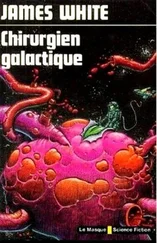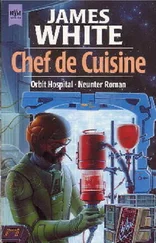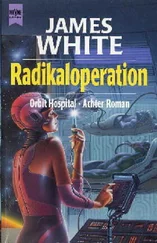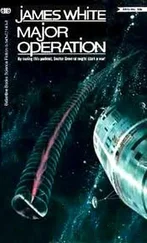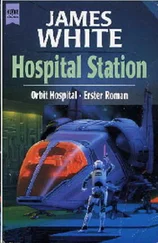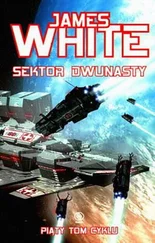In all directions they could see across the dark green, uneven carpet of treetops and clearings to the ragged edges where it met the beach. The medical station looked like a collection of white building-blocks standing in the dark, lengthening shadows of approaching evening, and the ocean was empty except for a tight group of pale blue swellings that were probably the mountaintops of a large island that was below the horizon. Danalta extruded an appendage to point slightly to one side of the distant mountains.
“Look,” it said. “I can see a bird. Do you?”
Murchison stared hard in the indicated direction. She thought she saw a tiny, fuzzy speck almost touching the horizon, but it could just as easily have been her imagination.
“I can’t be sure. ” she began, and broke off to stare at the thick cylindrical member that was growing out of the top of Danalta’s head. “Now what are you doing?”
“I’m maximizing my visual acuity,” it replied, “by positioning a lens of long focal length the required distance from my retina and making small focusing adjustments. Since the material is organic and the viewing base is moving perceptibly in the wind, some distortion is to be expected, but I’m sure that I can resolve the image to show…”
“You mean you’re growing a telescope?” she broke in. “Dr. Danalta, you never cease to surprise me.”
“Definitely some kind of bird,” it said — obviously pleased at the compliment — and went on, “with a small body, wide, narrow wings and a triangular tail whose outer edges are uneven. At this distance the size is uncertain. It appears to be dark brown or grey in color and non-reflective. It has a short, thick neck but I cannot resolve any details of the head and there are no other body projections, so presumably its legs are folded for aerodynamic reasons. The wings do not appear to be beating and it seems to be soaring on the air currents. It is close to the horizon and shows no sign of dropping below it.
“Birds did not evolve on my home planet,” it went on, “but I have studied the various species with a view to possible mimicry. So far, the general appearance and behavior of this one resembles that of a carrion-eater found on your own planet. At this range anything else I could tell you would be mostly guesswork.”
“Let’s go back to the station,” said Murchison quietly. “I want to be there before sunset.”
Danalta had spotted the planet’s first bird, she thought, as she climbed to the ground, and it seemed to be the equivalent of an outsized vulture, with all that that implied. It was silly to feel so disappointed just because this perfect-seeming world had shown its first imperfection.
Captain Fletcher and Lieutenant Dodds were being extremely careful, Prilicla noted with approval, and displaying a level of vigilance that elevated caution to the status of a major art form. Phis time they were using Rhabwar’s pinnace, a vehicle normally used for evacuating space-wreck casualties whose condition was lot serious enough to require litters, to move a variety of specially insulated test equipment to a more convenient distance from the investigation site. All of the analyzers had one or more backups, in case they probed a sensitive area and the alien ship killed the instrument stone-dead as it had done to Terragars sensors.
Not for the first time the captain was reminding them that he test instruments and even the pinnace were expendable, but lot the people using them, which was the reason why they were wearing insulated, self-powered spacesuits.
Rhabwar maintained its distance with a communications channel open while they edged to a stop a few meters above the damaged area of the alien’s hull, then tethered their vehicle loosely to it with a simple magnetic pad attached to a non-onducting cable.
“Sir,” the lieutenant said as they were exiting the vehicle,Dr. Prilicla says that this damaged area of hull — what it calls he surface wound — has apparently become desensitized to outside stimuli and we can safely make contact there. But shouldn’t we check to make sure that other areas haven’t been affected due to a power leakage or other deterioration in its sensor circuitry? I suggest making a few random tests. It might be that this metal carcass is dead by now and our precautions are wasting time.”
“If it can be done without you killing yourself, Lieutenant,” said the captain, “then do it. You agree, Doctor?”
“Yes,” said Prilicla. “That information would be helpful, friend Dodds. Especially if you can find another access hatch that is closer to the ship’s brain section. From here we’ll have to travel the internal walkways for more than half the length of the ship. But be very careful.”
“Of course,” said Dodds. “This might be the only life I’ve got.”
They watched as it positioned its powered suit a few meters from the hull and began the first slow, lateral circuit of the ship that became a spiral leading forward. Several times the lieutenant disappeared from view and Prilicla felt the captain’s controlled worrying, but Dodds was in sight when it made its find.
“Sir,” it said excitedly, “I’ve found what could be a cargo loading hatch. It’s about ten meters in diameter, flush-fitting, and the joins are so fine I almost missed them. Inset is a two-foot rectangle, that looks as if it might give access to the actuator controls. Along one side there is a group of three recessed buttons, but I won’t touch them until I have some idea of what they do and, in case they’re booby-trapped in some way, the order in which they should be pressed. I’m moving closer with the sensor now. The magnetic pads are holding it to the hull. I’ve switched on- So far, no response from the ship.”
The captain’s level of worrying peaked then began to sub-side. It didn’t speak.
“I’m using minimum power on the sensor,” the lieutenant went on, “so the image I’m getting is by induction rather than direct contact with the underlying circuitry, and pretty vague.
The wiring is complex, and active. To trace the leads to the three actuator buttons, I’ll need to clarify the picture by using a little more power… Bloody hell, the ship just did a Terragar on it! I’m sorry, sir, we need another K-Three-thirty sensor. This one just died.”
“Don’t worry about it,” said Fletcher. “It’s expendable You’re not. Continue your search aft, report anything you find and then get back here and follow us inside. We’ll have to go in the long way.”
To Prilicla it went on. “This vessel’s weapons system baffles me. So far there has been no sign of missile launchers, focused radiation projectors, or anything that might be an other-species equivalent. They could still be there and I just didn’t recognize them, but… I’m reminded of a porcupine.”
Prilicla didn’t ask the obvious question because he knew it would be answered when the other’s thoughts stopped moving too fast for any possible verbal communication. They were inside the ship at the first junction of the netting walkways and turning in the direction of the control section before the other spoke.
“It is a small, non-sapient Earth life-form,” the captain went on, “with a soft body that has no natural weapons of attack, but it possesses an overall covering of body-spines that are long and sharp enough to discourage predators. If that was the situation here, then killing Terragar’s operating systems could have been a mistaken act of self-defense because the aliens didn’t know our ship was simply trying to give assistance.”
“A not entirely comforting theory, friend Fletcher,” said Prilicla. “It infers that there are other species, or perhaps other members of their own species, who wanted to attack it. Why? Do they consider it a threat of some kind, or their prey? Either way, they were able to inflict heat and blast damage. Remember, offensive weapons were used against this vessel.”
Читать дальше

